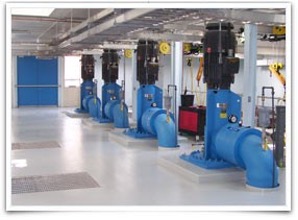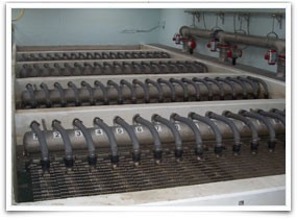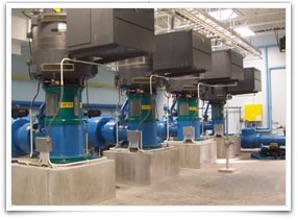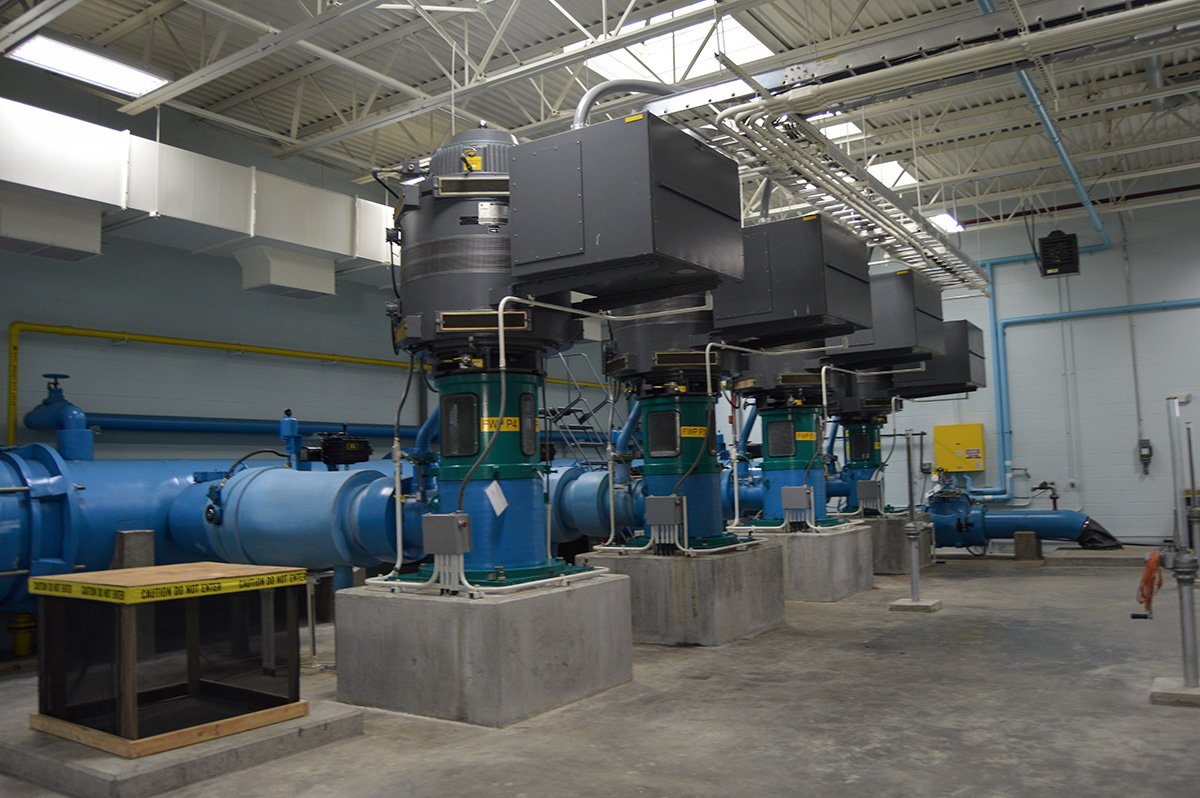The Water Utility has two state-of-the-art water treatment plants, which utilize microfiltration membranes as an absolute physical barrier to pathogenic organisms found in Lake Michigan, such as Cryptosporidium and Giardia.
The Water Treatment Plants currently treat an average of 13 million gallons of water per day from Lake Michigan with a maximum capacity of 20 million gallons per day.
Facilities
- Water Treatment Plant and High Service Pumps
- Finished Water Pump Station
- Collector A
- Collector C
The Water Treatment Process
-

Lake water enters the raw water pump houses through two intakes located one mile and two miles off the Lake Michigan shoreline.
- The first of the two intakes, two miles from shore, carries lake water into the original raw water pump house where a traveling screen removes large solids such as driftwood and vegetation.
- The water is then pumped into the plant through a 500-micron (0.02 in) screen to remove smaller particles such as sand and silt.
- The second intake, 4,000 feet long, completed in 2006, carries water into a new, raw water pump house. Together the two intakes bring enough water into the MPU Microfiltration plant to supply water not only to the City of Manitowoc, but also to the seven communities served by the Central Brown County Water Authority (CBCWA).
 Next, water passes through the microfiltration arrays in either the original pressurized microfiltration plant or the new energy-efficient submerged arrays.
Next, water passes through the microfiltration arrays in either the original pressurized microfiltration plant or the new energy-efficient submerged arrays.- The arrays are filled with hundreds of thousands of tiny hollow filters (think of them as tiny, flexible, porous, plastic straws) that remove bacteria-sized particles. These particles are as small as 0.1 micron (about 1/100 the diameter of a human hair) – particles much smaller than we can see, but which may be problematic for our water supply and our community.
Microfiltration at a Glance
The untreated water is pumped to the filters and forced through the holes in the sides of the straws using water pressure or vacuum. Pathogenic organisms and other particulate matter accumulate on the outer walls of the straws. The filtered water flows through the straws and out of the array, then into the storage and distribution system. Along the way, three chemicals are added: Chlorine, to disinfect the filtered water and keep it safe through the distribution system; Fluoride, for healthy teeth; and Polyphosphate, to protect the water from leaching lead or copper from old pipes and/or plumbing. Periodically (typically from two to three times each hour, as needed), a mixture of air and water bursts backwards through the membrane wall and dislodges and removes the accumulated particulate matter. Similarly, an occasional chemical cleaning of the membranes is required to remove particulate matter that was not removed during the backwash process.
 The two water treatment systems work in tandem. An interconnection between the Water Treatment Plants provides a redundant and reliable filtered water supply. Furthermore, when additional water is needed to augment the water that passes through the microfiltration process, clean groundwater is collected from an underground well known as “Collector C.” This well utilizes horizontal shafts, like the spokes of a wheel, to increase collection capacities.
The two water treatment systems work in tandem. An interconnection between the Water Treatment Plants provides a redundant and reliable filtered water supply. Furthermore, when additional water is needed to augment the water that passes through the microfiltration process, clean groundwater is collected from an underground well known as “Collector C.” This well utilizes horizontal shafts, like the spokes of a wheel, to increase collection capacities.
Water Quality Laboratory
The Water Treatment Plant is home to the City of Manitowoc’s Water Quality Laboratory. State Certified Water Operators in the lab conduct sampling and analysis of water samples from our water system. Water that passes through the microfiltration process undergoes up to 20 tests each day in the MPU Water Treatment Plant Laboratory.
Please see our Drinking Water Quality Report for more information!
Water Distribution
Water flows from the Water Treatment Plant to homes and businesses throughout Manitowoc via a network of underground pipes. The MPU Water Utility is responsible for the operation and maintenance of over 191 miles of water mains, more than 2,972 water valves and 1,345 fire hydrants in and around the City of Manitowoc. The Water Utility also reserves up to 9 million gallons of water that is stored in one of the three elevated water towers or an underground reservoir.
MPU Water Construction Specifications
Facilities
- New York Pump Station and Reservoir
- Southwest Pump Station
- Reed Ave water tower
- Industrial Park water tower
- Northwest water tower

